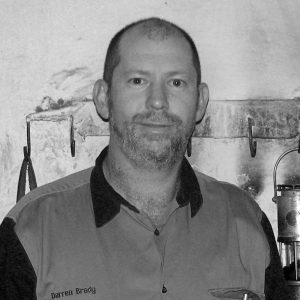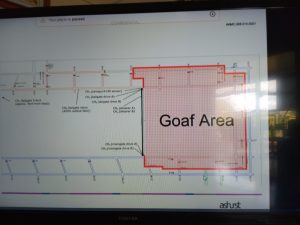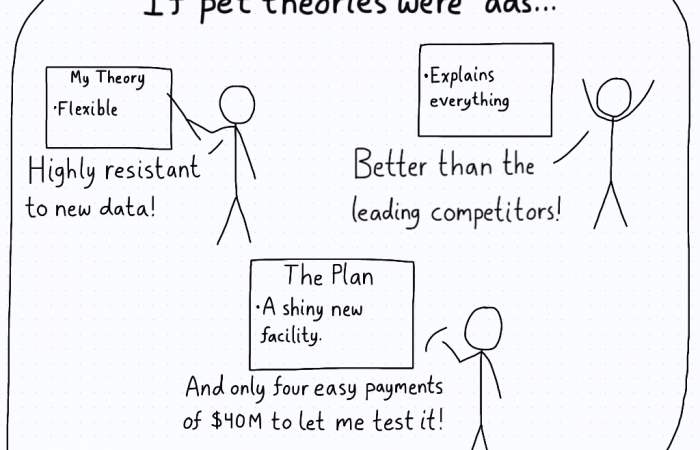
“Little Britton” Longwall Ventilation Arrangement at Grosvenor Mine LW 104. How does it compare with Mine Design Guideline MDG1006? Not well.
Consultants/Researchers Cliff, Brady and Watkinson make the following comment in their Paper



To provide guidance in developing these plans the then NSW Department of Industry and Innovation, issued a revised Mine Design Guideline MDG1006 with an accompanying technical reference guide (TRG) (NSW DII, 2011a and b). The TRG is an excellent and detailed technical reference document, and includes details of 23 incidents that have occurred since 1970.
Developments in the Management of Spontaneous Combustion in Australian Underground Coal
Mines by David Cliff (U of Q), Darren Brady (ex SIMTARS now a consultant) and Martin Watkinson (SIMTARS)
Developments in the Management of Spontaneous Combustion in Austr
HAZARD MANAGEMENT PLANS
A consequence of the Moura No.2 mine disaster was the reform of the coal mining safety and health legislation in NSW and Queensland to include the requirement for principal/major hazard management plans to control the risk due to spontaneous combustion.
This facilitated a more systematic control approach whereby risk management principles were applied and mines had to demonstrate that they had assessed the potential for spontaneous combustion, identified the controls required.
These plans must then outline the details of how the controls would be implemented and how their effectiveness would be monitored. Consistent with AS4804:2001, Occupational Health and Safety Management Systems – General Guidelines on principles, systems and supporting techniques, the plans must then identify key responsibilities, resourcing requirements and training needs.
To provide guidance in developing these plans the then NSW Department of Industry and Innovation, issued a revised Mine Design Guideline MDG1006 with an accompanying technical reference guide (TRG) (NSW DII, 2011a and b). The TRG is an excellent and detailed technical reference document, and includes details of 23 incidents that have occurred since 1970.
https://www.resourcesregulator.nsw.gov.au/__data/assets/pdf_file/0006/419514/MDG-1006-TR-spontaneous-combustion-management.pdf
MDG-1006-TR-spontaneous-combustion-management
A big problem for relying on this MDG is that it is a New South Wales Standard.
It has no direct legal link to the Queensland Coal Mining Safety and Health Act and Regulations, as it is not called up.
How does the “Little Britton” Ventilation Arrangement used in LW 104 at Grosvenor Mine compare to MDG 1006.?
I have cut and pasted what I consider the most relevant sections of the MDG.
I would easily suggest that “Little Britton” fails on every count.
Given what Cliff, Brady and Watkinson published in 2014 they would have to agree.
Maybe Counsel Assisting or Other Parties should ask better evidence based questions when they get the likes of Martin Watkinson in the stand and under oath
4.4.9 Gas Drainage
Generally it appears that pre-drainage of gas from the coal may increase the likelihood of spontaneous combustion occurring.
Gas drainage using negative pressures may contribute to the development of a heating by promoting a flow of air into a permeable coal seam or a mined out area.
Ideally the rate of gas extraction should not exceed the desorption rate.
The hazard exists when the oxygen level in the drained mixture rises above 8%. Sampling of the drained gas should be practised to reveal any entry of oxygen and to determine the levels of carbon monoxide within the system.
Pre-drainage of the coal seam also removes much of the free water. The water is drawn out of
the drainage holes with the gas flow. Drying the coal makes it more powdery which increases the dust generated during mining.
This produces dry, more finely divided coal dust that may settle in the goaf. This increases the reactivity of the coal and consequently the likelihood of heatings.
The removal of the water from the seam also increases the permeability of the goaf and increases the ingress of air into the seam.
Table 3: Relative Risk of Heatings – Longwall Methods Low to Higher
Retreat Mining (full seam thickness in one pass)
Retreat Mining (in tops of thick seam)
Retreat Mining (in middle of thick seam)
Retreat Mining (in bottom of thick seam)
* Risk will increase with wider longwalls due to relative rates of retreat
In longwall workings there are voids along the edges of the goaf adjacent to ventilated roadways where fresh air can intrude and flow if the goaf is not efficiently contained and inertised.
Areas where voids in the goaf exist and the likelihood of the development of heatings increase are:
Face Start Line – air may percolate into the original face start line. This may be due to the
high standard of support in this installation roadway.
Face Finish Line – This is controlled by rapid salvage of face equipment and by design of adequate final barrier pillars. The risk may arise if face recovery is delayed by equipment failures, industrial action or mining conditions.
4.4.17 Ventilation Pressure Difference
A pressure difference between two areas in a mine will cause air to flow from the higher to the lower pressure area. The amount of air that flows along each path depends upon the resistance to flow. This can result in unplanned ventilation flows and air leakage.
High ventilation quantities and pressure differential may result in air leakage into or from a sealed area or through or around pillars which will increase the risk of spontaneous combustion.
A good example of this is the pressure difference between an active longwall face and the
ventilated gate road alongside the goaf of the active longwall, especially if it is a return.


4.4.18 Abutment Load & Pillar Crush
Excessive pillar yield may result in air being able to be drawn through the pillar by ventilation pressure differential.
Yielding pillars or ‘sacrificial roadways’ may be designed in order to prevent heave in the
maingate and to improve conditions at the face end.
These should not be used in areas with a moderate to high propensity for spontaneous combustion unless adequate investigation and design work is carried out on the ventilation aspects of the design.
Pillar heatings have been encountered between intake and return airways, often near pit bottom.
They are normally associated with crushing of pillars or other mechanisms such as high ventilation pressure difference and open joints that create potential flow paths.
The abutment load from extraction areas will be carried on surrounding pillars.
Roadway convergence near stoppings may cause leakage to occur and result in poor inertisation of the goaf.
5.4 VENTILATION SYSTEM
Ventilation design tools to prevent spontaneous combustion include:
Reducing mine resistance and ventilation pressure
Providing a high standard of stoppings and seals & roadway support
Using low flow/ low pressure drop roadways alongside goaf areas
Using balance chambers to contain sealed areas
Injecting inert gases into balance chambers
Providing for inertisation or flooding of goaf areas
There should be a process in place for reviewing the potential impact on the spontaneous combustion risk prior to significant ventilation changes being implemented.
Ventilation systems that minimise pressure differentials across goaves or waste workings and along roadways adjacent to a goaf reduce the spontaneous combustion risk.
The simple ‘U’ system of ventilation is considered to be the most effective in preventing
spontaneous combustion in longwall workings.
However, this has a disadvantage in the return airflow passing alongside the adjacent goaf. Leakage through stoppings in this area will generate an induced airflow through the goaf, which may lead to a heating.
5.4.1 Pressure Difference
Placing values on the pressure difference across a goaf and along a roadway adjacent to a goaf is important in setting a standard for the mine that reduces the risk of spontaneous combustion.
A low pressure difference across a goaf can significantly reduce leakage through seals and stoppings.
Setting values is important to establish a standard for the mine.
Values are dependent upon the circumstances in the mine and may include:
- Extracted seam thickness
- Length of longwall block
- Number of access roadways
- Standard of stoppings and seals
- Gas make in the goaf
- Pillar and seal stress environment/regime
Reducing the pressure difference is not the only control adopted for prevention of spontaneous combustion.
The impact of barometric variations is significant and values most often exceed the pressure difference across a goaf.
Reliance on minimising leakage is dependent upon the standards of seals.
5.11 BOREHOLES & WELLS
Boreholes, if not required for further use, should be filled using a method that ensures the hole is completely filled without air gaps. Details of the driller, process used to fill the hole and company supervision etc. should be recorded.
A register of boreholes, wells, or gas wells placed anywhere in the lease should be kept with the following information:
- Location
- Depth
- Diameter
- Condition as at date
- Purpose
- Capped/ uncapped/ filled
- Driller & drillers log
Boreholes placed within the area of the subsidence effects of a goaf should be monitored to ensure that air is not passing into the goaf. The flow from gas wells may reverse at some stage when gas pressure in the goaf reduces.
Experimentally H2 has been shown to be given off at temperatures below 100C and C2H4 at 100-120C.
These temperatures are approximate and will vary for different coals.
The use of modern detection techniques now allows traces of these gases to be detected sooner in the self-heating process.
As temperatures exceed those required for the evolution of gases such as ethylene, the situation is rapidly approaching thermal runaway and would be at the stage where the mine goaf spontaneous combustion TARPS will require withdrawal of people.
It is important to realise that all the time taken for a heating to develop to a dangerous stage is not available because there is no way to be certain when the heating has started.
Time will elapse before the heating is first detected.
Only the time from when the heating is first detected to when men must be withdrawn is available for effective action.
This may be weeks or even days depending upon the coal type and environmental condition


